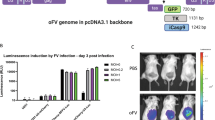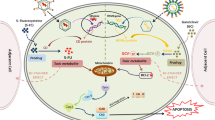Abstract
A retroviral vector constructed from the murine leukemia virus (MLV) can only express transgenes in cells undergoing mitosis, indicating its suitability as a delivery vehicle for cancer gene therapy. However, the transduction efficiency (TE) of retroviruses embedding endogenous envelope proteins in human cancer cells was found to be unsatisfactory. Recently, several research groups have demonstrated the feasibility of a retroviral vector pseudotyped with a vesicular stomatitis virus G (VSV-G) protein. In this study, the potential of VSV-G pseudotyped MLV-based retrovirus was examined as a delivery vehicle in a variety of human cancer cells including brain tumor cells in vitro and in vivo. The transduction efficiency of the 293T/G/GP/LacZ retrovirus in cell culture was superior in most cancer cells, particularly in brain tumor cells, compared with that of other retroviruses, such as PA317- or PG13-derived. The relative growth rate and phosphatidylserine expression level on the plasma membrane of target cells mainly influenced the transduction efficiency of VSV-G pseudotyped retrovirus, which suggested that both the relative growth rate and phosphatidylserine expression level were major determinants of TE. Furthermore, 293T/G/GP/LacZ could efficiently transduce human cancer cells regardless of the presence of chemical additives, whereas in other retroviruses, cationic chemical additives such as polybrene or liposomes were essential during virus infection. Finally, an average of 10% gene expression was routinely obtained exclusively in the tumor mass when 293T/G/GP/LacZ concentrated by simple ultracentrifugation was directly administrated to pre-established brain tumors in animal models (U251-N nu/nu mice or C6 Wistar rats). All told, the present study suggests that the VSV-G pseudotyped retrovirus is a suitable vector for brain tumor gene therapy.
This is a preview of subscription content, access via your institution
Access options
Subscribe to this journal
Receive 12 print issues and online access
$259.00 per year
only $21.58 per issue
Buy this article
- Purchase on Springer Link
- Instant access to full article PDF
Prices may be subject to local taxes which are calculated during checkout





Similar content being viewed by others
References
Robbins PD, Tahara H, Ghivizzani SC . Viral vectors for gene therapy Trends Biotechnol 1998 16: 35–40
Miller DG, Adam MA, Miller AD . Gene transfer by retrovirus vectors occurs only in cells that are actively replicating at the time of infection Mol Cell Biol 1990 10: 4239–4242
Roe T, Reynolds TC, Yu G, Brown PO . Integration of murine leukemia virus DNA depends on mitosis EMBO J 1993 12: 2099–2108
Culver KW et al. In vivo gene transfer with retroviral vector-producer cells for treatment of experimental brain tumors Science 1992 256: 1550–1552
Hurford RKJ, Dranoff G, Mulligan RC, Tepper RI . Gene therapy of metastatic cancer by in vivo retroviral gene targeting Nat Genet 1995 10: 430–435
Friedmann T, Yee JK . Pseudotyped retroviral vectors for studies of human gene therapy Nature Med 1995 1: 275–277
Vile RG, Russell SJ . Retroviruses as vectors Br Med Bull 1995 51: 12–30
Miller AD, Rosman GJ . Improved retroviral vectors for gene transfer and expression BioTechniques 1989 7: 980–990
Miller AD . Retroviral vectors Curr Top Microbiol Immunol 1992 158: 1–24
Miller AD . Cell-surface receptors of retroviruses and implications for gene transfer Proc Natl Acad Sci USA 1996 93: 11407–11413
Movassagh M et al. High-level gene transfer to cord blood progenitors using gibbon ape leukemia virus pseudotype retroviral vectors and an improved clinically applicable protocol Hum Gene Ther 1998 9: 225–234
Song JJ et al. Enhancement of gene transfer efficiency into human cancer cells by modification of retroviral vectors and addition of chemicals Oncol Rep 2000 7: 119–124
Takeuchi Y et al. Type C retrovirus inactivation by human complement is determined by both the viral genome and the producer cell J Virol 1994 68: 8001–8007
Yang Y et al. Inducible, high-level production of infectious murine leukemia retroviral vector particles pseudotyped with vesicular stomatitis virus G envelope protein Hum Gene Ther 1995 6: 1203–1213
Ory DS, Neugeboren BA, Mulligan RC . A stable human-derived packaging cell line for production of high titer retrovirus/vesicular stomatitis virus G pseudotypes Proc Natl Acad Sci USA 1996 93: 11400–11406
Coffin JM, Hughes SH, Varmus HE (eds) . Development and application of retroviral vectors Retroviruses Cold Spring Harbor: New York 1997 pp 437–473
Cornetta K, Anderson WF . Protamine sulfate as an effective alternative to polybrene in retroviral-mediated gene-transfer: implications for human gene therapy J Virol Meth 1989 23: 187–194
Toyoshima K, Vogt PK . Enhancement and inhibition of avian sarcoma viruses by polycations and polyanions Virology 1969 38: 414–426
Zabner J et al. Cellular and molecular barriers to gene transfer by a cationic lipid J Biol Chem 1995 270: 18997–19007
Themis M et al. Enhanced in vitro and in vivo gene delivery using cationic agent complexed retrovirus vectors Gene Therapy 1998 5: 1180–1186
Porter CD et al. Cationic liposomes enhance the rate of transduction by a recombinant retroviral vector in vitro and in vivo J Virol 1998 72: 4832–4840
Emi N, Fridemann T, Yee JK . Pseudotype formation of murine leukemia virus with the G protein of vesicular stomatitis virus J Virol 1991 65: 1202–1207
Arai T, Takada M, Ui M, Iba H . Dose-dependent transduction of vesicular stomatitis virus G protein-pseudotyped retrovirus vector into human solid tumor cell lines and murine fibroblasts Virology 1999 260: 109–115
Yu H et al. High efficiency in vitro gene transfer into vascular tissues using a pseudotyped retroviral vector without pseudotransduction Gene Therapy 1999 6: 1876–1883
Burns JC et al. Vesicular stomatitis virus G glycoprotein pseudotyped retroviral vectors: concentration to very high titer and efficient gene transfer into mammalian and nonmammalian cells Proc Natl Acad Sci USA 1993 90: 8033–8037
Yee JK et al. A general method for the generation of high-titer, pantropic retroviral vectors: highly efficient infection of primary hepatocytes Proc Natl Acad Sci USA 1994 91: 9564–9568
Costello E et al. Gene transfer into stimulated and unstimulated T lymphocytes by HIV-1-derived lentiviral vectors Gene Therapy 2000 7: 596–604
Morgenstern JP, Land H . Advanced mammalian gene transfer: high titre retroviral vectors with multidrug selection markers and a complementary helper-free packaging cell line Nucleic Acids Res 1990 18: 3587–3596
Gossen M, Bujard H . Tight control of gene expression in mammalian cells by tetracycline-responsive promoters Proc Natl Acad Sci USA 1992 89: 5547–5551
Song JJ et al. Transduction effect of antisense K-ras on malignant phenotypes in gastric cancer cells Cancer Lett 2000 157: 1–7
Mastromarino P et al. Characterization of membrane components of the erythrocyte involved in vesicular stomatitis virus attachment and fusion at acidic pH J Gen Virol 1987 68: 2359–2369
Hall MP, Burson KK, Huestis WH . Interactions of a vesicular stomatitis virus G protein fragment with phosphatidylserine: NMR and fluorescence studies Biochim Biophys Acta 1998 1415: 101–113
Koopman G et al. Annexin V for flow cytometric detection of phosphatidylserine expression on B cells undergoing apoptosis Blood 1994 84: 1415–1420
Sinclair AM et al. Interaction of vesicular stomatitis virus-G pseudotyped retrovirus with CD34+ and CD34+CD38− hematopoietic progenitor cells Gene Therapy 1997 4: 918–927
Vermes I, Haanen C, Steffens-Nakken H, Reutelingsperger C . A novel assay for apoptosis flow cytometric detection of phosphatidylserine expression on early apoptotic cells using fluorescein labelled annexin V J Immunol Meth 1995 184: 39–51
Takeuchi Y et al. Sensitization of rhabdo-, lenti-, and spumaviruses to human serum by galactosyl(α1–3)galactosylation J Virol 1997 71: 6174–6178
Galipeau J et al. Vesicular stomatitis virus G pseudotyped retrovector mediates effective in vivo suicide gene delivery in experimental brain cancer Cancer Res 1999 59: 2384–2394
Brandes A, Soesan M, Fiorentino MV . Medical treatment of high grade malignant gliomas in adults: an overview Anticancer Res 1991 11: 719–727
Ram Z . Advances in the diagnosis and treatment of malignant brain tumors Isr Med Assoc J 1999 1: 188–193
Cool V et al. Curative potential of herpes simplex virus thymidine kinase gene transfer in rats with 9L gliosarcoma Hum Gene Ther 1996 7: 627–635
Sasaki M, Plate KH . Gene therapy of malignant glioma: recent advances in experimental and clinical studies Ann Oncol 1998 9: 1155–1166
Acknowledgements
We thank Dr R Mulligan for kindly providing pBC.tTA, pMDtetG and pMD.gagpol. This work was supported by a grant from the Ministry of Public Health of the Republic of Korea (HMP-98-B-3–0021, H Lee). Dr J-H Kim and JW Chang are also supported by Brain Korea 21 Project for Medical Sciences Yonsei University.
Author information
Authors and Affiliations
Rights and permissions
About this article
Cite this article
Lee, H., Song, J., Kim, E. et al. Efficient gene transfer of VSV-G pseudotyped retroviral vector to human brain tumor. Gene Ther 8, 268–273 (2001). https://doi.org/10.1038/sj.gt.3301390
Received:
Accepted:
Published:
Issue Date:
DOI: https://doi.org/10.1038/sj.gt.3301390
Keywords
This article is cited by
-
Construction of a replication-competent retroviral vector for expression of the VSV-G envelope glycoprotein for cancer gene therapy
Archives of Virology (2020)
-
A new chemical complex can rapidly concentrate lentivirus and significantly enhance gene transduction
Cytotechnology (2018)
-
Engineering protein nanocages as carriers for biomedical applications
NPG Asia Materials (2017)
-
Engineered retroviral virus-like particles for receptor targeting
Archives of Virology (2014)
-
VSV-G pseudotyped, MuLV-based, semi-replication-competent retrovirus for cancer treatment
Gene Therapy (2006)



